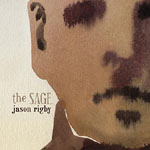Home » Jazz Articles » Album Review » Jason Rigby: The Sage
Jason Rigby: The Sage
The front line and rhythm section seem to be at cross-purposes on "Magenta": Rigby and Russ Johnson are in a shambling sort of unison, building not quite an echo as they play the establishing figure, while Gerald Cleaver and Cameron Brown are jumping on the floor and throwing the furniture around the room. The melody gets another level of texture and resonance when Mike Holober adds Fender Rhodes to the mix. It all seems counterproductive on its face, but "Magenta" is like one of those computer-generated pictures where the only way to see the actual picture is to find the right angle and squint. Cleaver and Brown's cacophony is a cleverly-camouflaged foundation for Rigby, Johnson and Holober to throw splashes of color against the wall, and the end result is both startling and satisfying.
A sense of anarchy can be found almost everywhere on The Sage, even on the thoughtful neo-ballad, "Shift of Color." While this may be a shift in direction from "Magenta" and the super-fast post-bop bomber "Crux," it's not an actual shift in color. There is a marvelous sense of immediacy on every track, as if Rigby detailed the grooves five minutes before the session and otherwise left everything to chance. "Tone Poem" is just that, with Rigby and Holober harmonizing and then creating a dizzying dialogue with Brown, while the hypnotic "Slip" swirls and slides as Holober lays down explosions of Rhodes that would make Herbie Hancock nod in approval.
Much of the anarchy comes from Cleaver, who is in his own private Idaho for most of the session; other than some nearly-straight timekeeping on the kinetic closer "Jealous Moon," Cleaver goes his own way throughout the date. He cuts a sizable swath on "Color," even on brushes, and his in-the-clear opening to the title track towers so high, Johnson's short solo figures make it seem like he doesn't want to interrupt. Johnson's overall tone dovetails perfectly with Rigby all the way through; Johnson keeps it open and anchored, while Rigby flirts with the same stratospheric heights Wayne Shorter explored with Miles.
The Sage gives purists something new to rail about: Not only does Jason Rigby revive music that presaged the recording Miles Haters love to hate, but Rigby and his partners do the job so extraordinarily well.
Track Listing
Magenta; Crux; Shift of Color; The Sage; Tone Poem; Slip; The Archer; Jealous Moon.
Personnel
Jason Rigby
saxophone, tenorJason Rigby: tenor and soprano saxophones, flute; Russ Johnson: trumpet; Mike Holober: Fender Rhodes; Cameron Brown: bass; Gerald Cleaver: drums.
Album information
Title: The Sage | Year Released: 2009 | Record Label: Fresh Sound New Talent
< Previous
Concert for the Comet Kohoutek
Comments
About Jason Rigby
Instrument: Saxophone, tenor
Related Articles | Concerts | Albums | Photos | Similar ToTags
For the Love of Jazz
 All About Jazz has been a pillar of jazz since 1995, championing it as an art form and, more importantly, supporting the musicians who create it. Our enduring commitment has made "AAJ" one of the most culturally important websites of its kind, read by hundreds of thousands of fans, musicians and industry figures every month.
All About Jazz has been a pillar of jazz since 1995, championing it as an art form and, more importantly, supporting the musicians who create it. Our enduring commitment has made "AAJ" one of the most culturally important websites of its kind, read by hundreds of thousands of fans, musicians and industry figures every month.




















